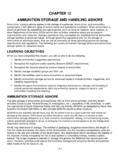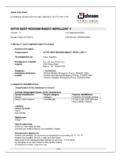Transcription of Technical Requirements For Aboveground Storage Tanks …
1 H:\ Technical References\Comm 10 Class IIIB Tank Page 1 of 4 Technical Requirements For Aboveground Storage Tanks (ASTs) Storing Class IIIB Liquids References: Comm 10 / NFPA 30 2003 EDITION ITEM DESCRIPTION Comm 10 / NFPA FLASH POINT NFPA 30 Combustible Liquid, Class IIIB Any liquid that has a flash point at or above 200 degree F. Flash point identified on the Material Safety Data Sheet (MSDS) is the reference. DEFINED AND REGULATED AS A COMM 10 TANK Comm 10 effective July 2002 Exempt: UST less than 60 gal. AST less than 110 gal. Significant Changes - Effective Date of Pending Code Revision PLAN REVIEW Requirements Required for all USTs and ASTs larger than 1,100 gallon capacity.
2 Comm (1)(b)3 REGISTRATION Requirements Required for all USTs and ASTs larger than 1,100 gallon capacity. Comm (1)(a)3 CONSTRUCTION STANDARD Comm (1) (c) Tanks for Class IIIB liquids. Tanks of 1,100 gallon or more capacity used for Aboveground Storage of Class IIIB liquids shall be listed or shall be acceptable to the department. (Accepted listings below) Comm (2) CONSTRUCTION. (a) Except as allowed under par. (b), Tanks containing flammable or combustible liquids shall be constructed to one of the recognized design standards in NFPA 30 or a standard approved by the department.
3 Note: Design standards recognized by NFPA 30 include API 12B, API 12D, API 12F, API 620, API 650, UL 58, UL 80, UL 142, UL 1316, UL 1746, UL 2080, UL 2085 and UL 2386. IBCs UL 2386 is the fire exposure test standard for IBC rated/approved for combustible liquid handling. The UL mark states specifically: "These Requirements cover intermediate bulk containers (IBC's) intended for the Storage of flammable and combustible liquids within warehouses and other Storage areas protected with automatic wet-pip sprinkler systems." NFPA 30 Chapter 4 addresses IBCs up to 800 gallon ANNUAL INSPECTION No Effective for Tanks installed after July 1, 2002 (Scope of Technical application in NFPA ) PLAN REVIEW Requirements Required for all USTs and ASTs regulated by Comm 10.
4 Comm (1) REGISTRATION Requirements Required. Comm TANK DESIGN & CONSTRUCTION Requirements (CONSTRUCTION MATERIAL) NFPA 30- Materials of Construction. Tanks shall be designed and built in accordance with recognized good engineering standards for the material of construction being used. Tanks shall be of steel or other approved noncombustible material, with the following limitations and exceptions: (a)The materials of construction for Tanks and their appurtenances shall be compatible with the liquid to be stored. In case of doubt about the properties of the liquid to be stored, the supplier, producer of the liquid, or other competent authority H:\ Technical References\Comm 10 Class IIIB Tank Page 2 of 4 shall be consulted.
5 (b) Tanks shall be permitted to be constructed of combustible materials only when approved by the authority having jurisdiction. Tanks constructed of combustible materials shall be limited to the following: (1) Underground installation (2) Use where required by the properties of the liquid stored (3) Aboveground Storage of Class IIIB liquids in areas not exposed to a spill or leak of Class I or Class II liquid (4) Storage of Class IIIB liquids inside a building protected by an approved automatic fire-extinguishing system. NFPA Design Standards for Atmospheric Tanks .
6 Atmospheric Tanks , including those incorporating secondary containment, shall be designed and constructed in accordance with recognized standards or approved equivalents. Atmospheric Tanks that meet any of the following standards shall be deemed as meeting the Requirements of : API 12B, API 12D, API 12F, API 650, UL 80, UL 142, UL 2080 and UL 2085 Comm (1)(c) Tanks for Class IIIB liquids. Tanks of 1,100 gallon or more capacity used for Aboveground Storage of Class IIIB liquids shall be listed or shall be acceptable to the department Tanks IN BUILDINGS NFPA shall apply to installations of Tanks storing Class I, Class II, and Class IIIA liquids in Storage tank buildings.
7 This subsection shall not specifically apply to such Tanks in process areas. (See Chapter 7.) Tanks storing Class IIIB liquids shall not be required to comply with the provisions of this subsection. However, adequate space must be provided for both tank and building maintenance. A tank installation that has a canopy or roof that does not limit the dissipation of heat or dispersion of flammable vapors and does not restrict fire-fighting access and control shall be treated as an outside Aboveground tank. TANK SPACING TANK-TO-TANK NFPA Shell to shell spacing between any two adjacent Aboveground Tanks .
8 Tanks storing Class I, II, III stable liquids shall be separated by the distances given in Table [Table at end of document.] Exception: Tanks used only for storing Class IIIB Liquids need not be separated by more than 3 feet provided they are not within the same diked area as or drainage path of a tank storing a Class I or II liquid. TANK TO PROPERTY LINE THAT CAN BE BUILT UPON AND TANK FROM IMPORTANT BUILDING NFPA Tanks storing Class IIIB stable liquids shall be located in accordance with Table Exception: If located within the same diked area as or the drainage path of a tank storing a Class I or Class II liquid, the tank storing Class IIIB liquid shall be located in accordance with NFPA 30 TABLE CLASS IIIB LIQUIDS.
9 [Table at end of document.] NOTE: For Tanks used for vehicle fueling refer to NFPA 30A. COLLISION PROTECTION Yes - NFPA OVERFILL PROTECTION Refer to NFPA A sight gauge is acceptable for Class IIIB liquid Storage . SECONDARY CONTAINMENT SPILL PREVENTION No - Not required for Class IIIB liquids - NFPA 30- Control of spills from Aboveground Tanks . Every tank that contains a Class I, Class II, or Class IIIA liquid shall be provided with means to prevent an accidental release of liquid from endangering important facilities and adjoining property or from reaching waterways.
10 FOUNDATION SUPPORTS AND PROTECTION No - Excludes Class IIIB - NFPA Steel structures or exposed piling for Tanks storing Class I, Class II, or Class IIIA liquids shall be protected by materials having a fire resistance rating of not less than 2 hours. H:\ Technical References\Comm 10 Class IIIB Tank Page 3 of 4 PIPING SYSTEMS NFPA 30-Chapter 3 Piping Systems. This chapter shall apply to piping systems consisting of pipe, tubing, flanges, bolting, gaskets, valves, fittings, flexible connectors, the pressure-containing parts of other components such as expansion joints and strainers, and devices that serve such purposes as mixing, separating, snubbing, distributing, metering, controlling flow, or secondary containment of liquids and associated vapors.





